Catalunya’s New Guard: Small-Scale Artisan Couple Alemany & Corrio in Pursuit of Terroir Expression and New Qualitative Heights (5-Bottle Pack $196)
Join us for Saturday Sips
On Saturday, we will continue our tasting tour of Catalunya, this week featuring the wines of Celler Alemany i Corrio for a look at Penedès through the palates of this dynamic couple.
This is an all-day event, so come and taste whenever it is convenient!
We continue our celebration of ‘All Things Catalunya’ with a climb high into the rarefied peaks of the Penedès highlands, best known for its Cava—the Spanish response to Champagne. But two of the many maverick winemakers who dot the region, especially the Alt-Penedès, are the focus of this week’s package. Irene Alemany and Laurent Corrio will allow us take a deep-dive into a mindset that is shaking off the cobwebs of convention by producing de-classified wines on their own terms. Sometimes labeled ‘garage wines’, these wines are—despite the moniker’s association with grease and oil—small-production gems of innovation and originality.
Irene Alemany and Laurent Corrio have been vinifying in Penedès since 1999, and represent two prime examples of the new thinking that has come to old wine country. Following organic principals and reducing yields while working with largely hand-crafted equipment, their simple cellar on the industrial side of Vilafranca del Penedès is producing distinctive wines from indigenous grapes like Xarel·lo and Macabeu while dabbling in interpretation of classic varieties like Merlot and Carignan—here called Carinyena—but always with a commitment to maximum fidelity to the earth on whose bounty the winery depends.
Penedès Highlands: Catalunya’s Elevated Wines
An hour southwest of Barcelona, Penedès may be best known for Cava, but the appellation refuses to be pigeonholed: The cutting-edge wines arising from the mountain vineyards are setting new standards for quality, especially the reds in an area in which nearly all the output is white.
Subdivided into three regions based on elevation (the coastal Baix-Penedès, the Garraf, and the Alt-Penedès) the appellation stretches westward and inland from the Mediterranean Sea over undulations known as the Catalan Coastal Depression, where the maritime range and the pre-coastal mountains see vines thriving at 2,600 feet.
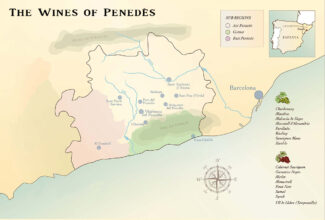
Although the dominant varieties here is Xarel·lo, one of the mandatory grapes used in Cava (along with Macabeu and Parellada), Chardonnay, Muscat, Riesling, Sauvignon Blanc and Chenin Blanc are growing in popularity. Smaller quantities of red grapes cover about 10,000 acres of Penedès vineyards, dominated by Merlot and Cabernet Sauvignon with the Spanish standbys, Carinyena and Tempranillo.
The climate is mostly Mediterranean, with mild winters and hot summers. But a changing climate is re-writing the book on the altitude where it is possible to grow grapes successfully in the Penedès highlands. Regardless of the weather, the soils are unchanged: The clay, sand and limestone substrates below the grapes are generally dry and friable, conducive to letting vine roots penetrate deeply.
Celler Alemany i Corrio
Maxim Fidelity to The Land
There are matches made in Heaven and those made in vineyards; credit the latter to the life partnership of Irene Alemany and Laurent Corrio, whose small-batch, low-intervention wines are proving that the Alt-Penedès is among the most exciting places to be making wine today. Great wine is a technical beast, but without the intensity of passion, it loses much of its savor: “Our wine is as soft as a gentle kiss, but one where you end by biting your partner’s lip,” says Irene.
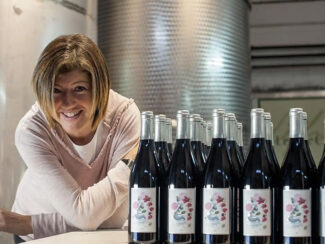
Irene Alemany, Celler Alemany i Corrio
The couple met at the University of Burgundy in Dijon, then apprenticed together in vineyards in France and California. But their future was written in chalk and loam following a visit to Irene’s parents in Lavern in the Penedès; that was when Irene’s father suggested that they consider using the family vines to start their own operation. This treasure trove encompassed several varieties of grapes between 25 and 60 years old. They leapt at the opportunity—their first harvest was in 1999 and their first bottling in 2002. From the beginning, they followed their French training, remaking the classics in their own way, keeping the process as natural as possible while seeking to reflect the expression of the varieties and the character of the terroir to the maximum extent.
In the process, they are credited with producing the first ‘garage’ wines of New Penedès. Their ‘Vi de Garatge’ series may be thought of as ‘tailor-made’ wines relying on precision in both field and cellar.
“What we want to accomplish,” says Irene, “is that when people taste our wines there is something in the soul of the wine that talks to them and will make them remember.”
Xarel·lo: French Inspiration With a Catalan Soul
All the exotic mysteries of Catalunya may be contained within a single word, Xarel·lo, which in its correct spelling contains a diacritic scarcely known outside the region—a small dot where we have placed a dash. It’s called a ‘punt volat’—a flying point, and indicates a glottal pause. The pronunciation, somewhere in the neighborhood of ‘shah (or ‘chah)-REL-LO’ introduces you to the most aromatic of the Cava trinity; it also makes a heady, hallowed still wine that ranks among Spain’s finest whites. Not only is it delicious, the grape is rich in polyphenols and high in the antioxidant resveratrol, often associated with red grapes and the mystery behind the formerly ballyhooed ‘French Paradox.’
If it’s a variety with which you are unfamiliar, chances are good that you are even less familiar with its parentage—it is a cross between Brustiano and Hebén. But the taste is something that you will retain for a long time, especially when vinified with the Burgundian gesture that Irene and Laurent bring to their Catalan cellar, producing Xarel·lo with structure and elegant aging potential, with a savory nuttiness that has been likened to Meursault.
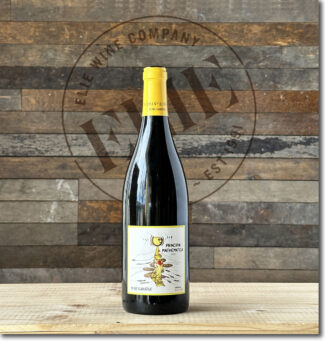 Celler Alemany i Corrio ‘Principia Mathematica’, 2021 Vi de Garatge ($26) White
Celler Alemany i Corrio ‘Principia Mathematica’, 2021 Vi de Garatge ($26) White
Originating with low-yields from a seven-acre plot where the vines are over fifty years old, Principia Mathematica was fermented in French oak (10% new) and aged for ten months in foudres/stainless steel. Parker’s Wine Advocate considers this the finest vintage of the 100% Xarel·lo that the Alemany-Corrios have produced. It shows crisp mineral notes behind a rich panoply of citrus fruits along with grassy hints of apricot and toasted nuts. 665 cases produced.
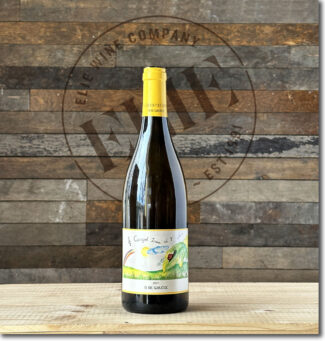 Celler Alemany i Corrio ‘Cargol Treu Vi’, 2021 Vi de Garatge ($31) White
Celler Alemany i Corrio ‘Cargol Treu Vi’, 2021 Vi de Garatge ($31) White
Another pure Xarel·lo beauty from the same vintage; Cargol Treu Vi comes from 75-year-old vines planted on chalky soil, then vinified on wild yeast in 300 liter French oak barrels, 25% new. The wine shows spring flowers, stone fruit and lemon zest behind hints of smoke with a long, salt-tinged finish. 175 cases produced.
Pas de Deux: Merlot with Carinyena in the Lead
Merlot is the most widely-planted red wine grape in the world; Carinyena, a.k.a Carignan, is found in quantity only along the Mediterranean coast. Still, they make such ideal wine companions that it is surprising that the blend is not more common. Merlot tends to be a fruit-driven wine with a silkiness that reaches a pinnacle in Pomerol and Saint-Émilion, but in warmer climate it seems to lack enough backbone to stand alone. Blended with Carinyena, known for its high levels of tannin, color and acidity, there is a beautiful balance that may be compared to Bordeaux’s classic Cabernet Sauvignon/Merlot matchup.
Although these wines are generally intended for early consumption, when produced using lutte raisonnée agriculture and low yields as is found in the Alemany i Corrio playbook, it makes a deeper, darker, most complex wine that can withstand time in the cellar and improve.
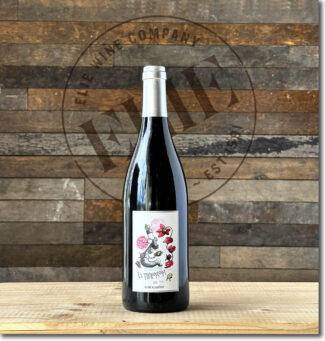 Celler Alemany i Corrio ‘El Microscopi’, 2019 Vi de Garatge ($26) Red
Celler Alemany i Corrio ‘El Microscopi’, 2019 Vi de Garatge ($26) Red
Another ‘garage wine’ from the Alemany-Corrio couple, the original plan was to use funds raised in sales to purchase a microscope for the Oncology Institute of the Hospital Universitari Vall d’Hebron in Barcelona where Irene was treated during the most difficult medical time in her life—hence, the name. 80% Carinyena and the 20% Merlot, the wine undergoes a 10-day pre-fermentation cold-soak maceration; the Carinyena ferments entirely in stainless steel while the Merlot spends time in some oak. The wine is then bottled without clarification or filtration after one year in tanks. Due to the COVID pandemic, the 2019 vintage wasn’t bottled until later. It shows an earthy nose with hints of garrigue herbs, cardamom and rich blackberry. 165 cases produced.
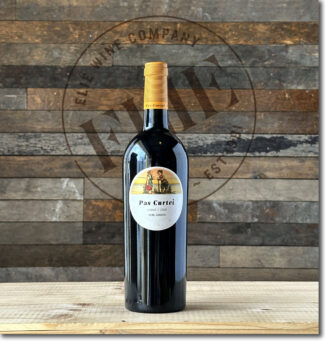 Celler Alemany i Corrio ‘Pas Curtei’, 2020 Vi de Garatge ($26) Red
Celler Alemany i Corrio ‘Pas Curtei’, 2020 Vi de Garatge ($26) Red
New meets old in this 40% Merlot, 35% Carinyena, 25% Cabernet Sauvignon blend from vines between 15 and 70 years old. It fermented destemmed after a five-day cold soak and matured in French oak barrels and a 1,000-liter oak foudre for 14 to 16 months. It shows rose and exotic spice on the nose, with a rich, ripe palate of cherry, blackberry and cassis intermixed with graphite, peat and light smoke. 583 cases produced.
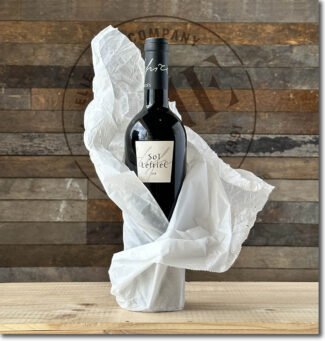 Celler Alemany i Corrio ‘Sot Lefrìec’, 2018 Vi de Garatge ($87) Red
Celler Alemany i Corrio ‘Sot Lefrìec’, 2018 Vi de Garatge ($87) Red
Sot Lefrìec is Alemany i Corrio’s flagship red, made from a hand-sorted blend of 50% Carinyena, 30% Merlot, 20% Cabernet Sauvignon from their oldest vineyards. All grapes are manually harvested and placed in small boxes after vineyard pre-sort. At winery, they are destemmed and undergo cold-soak maceration for more than a month. Malo fermentation takes place in new and single-use oak barrels where the wine rests for 22 months. Mature, robust and intense, it displays of ripe black current, forest floor, mushroom and elegant notes of leather, with a spine of freshness provided by the Carinyena.125 cases produced.
NEW ARRIVAL
Clos Petitona
(Priorat – Vi de Vila ‘Masos de Falset’)
A Burgundian Approach
A grasp of Priorat’s wines begins with the soil, but to understand the region, it must be noted that two decades ago, Priorat was an impoverished and isolated hinterland, scarcely known inside Spain let alone by the world at large. Around the turn of this century, however, a new generation discovered Priorat’s ancient wine traditions and potential. Some of these ‘newcomers’ had been here the entire time and began to revive family wineries and old vineyards. Others, like José Mas of Costers del Priorat came, saw and earned his reputation: “Some people work in wine because they have family vineyards. I’m part of Generation Zero. I don’t have any inherited obligation to work; it’s just my passion.”
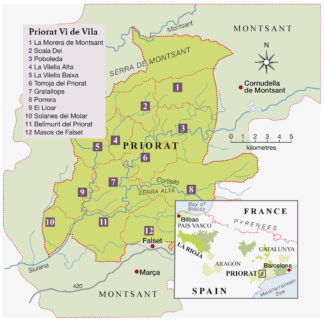
‘Els Noms de la Terra’ (The Names of the Land) is DOQ Priorat’s new, Burgundy-inspired classification system, among the most ambitious ever carried out by any Spanish wine producing region. As in Burgundy, the base of the Priorat pyramid is made of regional wines; they can be produced with grapes grown throughout the appellation and are labelled DOQ Priorat. Since the 2007 vintage, Vi de Vila (Village wine) is restricted to certain places approved by the Consejo, and following the 2017 vintage, Vi de Paratge was introduced, similar to climats or lieu-dits in Burgundy. Single-vineyard wines may be labelled either as Vinya Classificada (aligning with Premier Cru) or Gran Vinya Classificada (the equivalent of a Grand Cru).
Priorat: It’s All About The Slate
‘Llicorella’ may roll off the tongue like licorice, and that’s because the unique slate of Priorat takes its name from the famous root. It’s this feature which gives the wines of Priorat a striking minerality. Other similar metaphors can be made: Like the black version of the candy, the best Priorat wines share an inky color and a rich texture, while there is a fruity freshness in those grown at the highest altitudes on red clay.
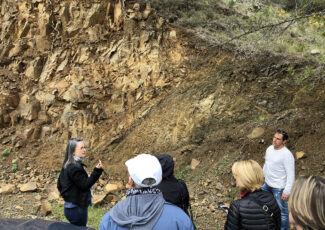
Masos de Falset Hillside composed of ‘Llicorella’ consisting of reddish-black slate with small particles of mica quartz, different layers of soil filled in by clayey soil, Clos Petitona winemaker Blai Ferré i Just to the right.
Fresh Approach: ‘Wake-Up’ Wines and Identity
Says Valenti llagostera of Mas Doix: “Priorat wines are wake-up wines, not sofa wines.”
Given the diversity of the land, there is no likelihood of him or anyone producing a textbook or recipe wine. Yet the best Priorat wines share a clear identity, usually with an inky color and a dense, rich texture. There is often a distinct freshness typical of Garnatxa grown at the highest altitudes on Llicorella and red clay.
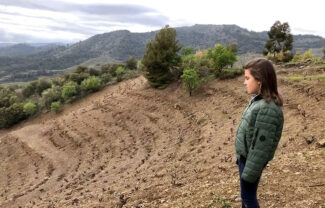
Clos Petitona, Priorat – Vi de Vila ‘Masos de Falset’
Unlike some labels from lesser known appellations, Priorat wines will never be inexpensive. Vineyards are tiny and working them can be brutal; they do not sell themselves in the market, and the price also reflects their relative scarcity. There are fewer that one hundred registered wineries in the entire region, far fewer than we have in Michigan.
Priorat now claims 459 ‘partages’—lieu-dit sites—with specific identifiable characteristics.
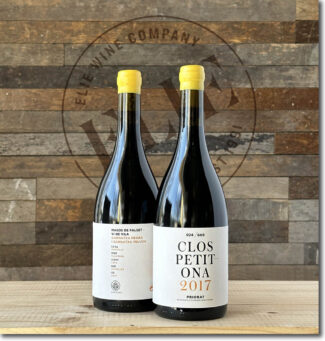 Clos Petitona, 2017 Priorat – Masos de Falset ($78)
Clos Petitona, 2017 Priorat – Masos de Falset ($78)
Clos Petitona is produced from a single plot located in the village of Falset, and is typical of the extreme slopes of the region, terraced against the ravages of time. It was planted in 1949 with equal parts Garnatxa Negra and Garnatxa Peluda vines, with a south-east orientation and a surface area of 3.5 acres. Due to the age of the vines, yields are extremely low, giving the wines superb concentration and structure. All treatments that are made in the vineyard are done using organic techniques. Fermentation takes place in thousand-liter open-top stainless-steel tanks, with punch-downs three times a day to achieve ideal extraction. Like the plot itself, Petitona is equal parts traditional Catalan Garnatxa and a variety known as Garnatxa Peluda—‘Hairy’ Garnatxa—because the vine leaves are covered in fine hairs that make it drought resistant. Perfumed rather than floral, the wine shows an earthen nose with baking spice and especially, a touch of licorice-ash, allowing the soil llicorella to live up to its name.
- - -
Posted on 2023.04.26 in Saturday Sips Wines, Spain DO, Penedes, Wine-Aid Packages
Featured Wines
- Notebook: A’Boudt Town
- Saturday Sips Wines
- Saturday Sips Review Club
- The Champagne Society
- Wine-Aid Packages
Wine Regions
Grape Varieties
Albarino, Albarín Blanco, Albarín Tinto, Albillo, Aleatico, Aligote, Arbanne, Aubun, Barbarossa, barbera, Biancu Gentile, bourboulenc, Cabernet Franc, Caino, Caladoc, Calvi, Carcajolu-Neru, Carignan, Chablis, Chardonnay, Chasselas, Cinsault, Clairette, Corvina, Counoise, Dolcetto, Erbamat, Ferrol, Frappato, Friulano, Fromenteau, Gamay, Garnacha, Garnacha Tintorera, Gewurztraminer, Graciano, Grenache, Grenache Blanc, Groppello, Juan Garcia, Lambrusco, Loureira, Macabeo, Macabou, Malbec, Malvasia, Malvasia Nera, Marcelan, Marsanne, Marselan, Marzemino, Mondeuse, Montanaccia, Montònega, Morescola, Morescono, Moscatell, Muscat, Natural, Niellucciu, Parellada, Patrimonio, Pedro Ximénez, Petit Meslier, Petit Verdot, Pineau d'Aunis, Pinot Blanc, Pinot Gris, Pinot Meunier, Pinot Noir, Pouilly Fuisse, Pouilly Loche, Poulsard, Prieto Picudo, Riesling, Rondinella, Rose, Rousanne, Roussanne, Sagrantino, Sauvignon Blanc, Savignin, Sciacarellu, Semillon, Souson, Sparkling, Sumoll, Sylvaner, Syrah, Tannat, Tempranillo, Trebbiano, Trebbiano Valtenesi, Treixadura, Trousseau, Ugni Blanc, vaccarèse, Verdicchio, Vermentino, Xarel-loWines & Events by Date
- July 2024
- June 2024
- May 2024
- April 2024
- March 2024
- February 2024
- January 2024
- December 2023
- November 2023
- October 2023
- September 2023
- August 2023
- July 2023
- June 2023
- May 2023
- April 2023
- March 2023
- February 2023
- January 2023
- December 2022
- November 2022
- October 2022
- September 2022
- August 2022
- July 2022
- June 2022
- May 2022
- April 2022
- March 2022
- February 2022
- January 2022
- December 2021
- November 2021
- October 2021
- September 2021
- August 2021
- July 2021
- June 2021
- May 2021
- April 2021
- March 2021
- February 2021
- January 2021
- December 2020
- November 2020
- October 2020
- September 2020
- August 2020
- July 2020
- June 2020
- May 2020
- April 2020
- March 2020
- February 2020
- January 2020
- December 2019
- November 2019
- October 2019
- September 2019
- August 2019
- July 2019
- June 2019
- May 2019
- April 2019
- March 2019
- February 2019
- January 2019
- December 2018
- November 2018
- October 2018
- September 2018
- August 2018
- July 2018
- June 2018
- May 2018
- April 2018
- March 2018
- February 2018
- January 2018
- December 2017
- November 2017
- October 2017
- September 2017
- August 2017
- July 2017
- June 2017
- May 2017
- April 2017
- March 2017
- February 2017
- January 2017
- December 2016
- November 2016
- October 2016
- September 2016
- August 2016
- July 2016
- June 2016
- May 2016
- April 2016
- March 2016
- February 2016
- January 2016
- December 2015
- November 2015
- October 2015
- September 2015
- August 2015
- July 2015
- June 2015
- May 2015
- April 2015
- March 2015
- February 2015
- January 2015
- December 2014
- November 2014
- October 2014
- September 2014
- August 2014
- July 2014
- June 2014
- April 2014
- March 2014
- February 2014
- January 2014
- December 2013
- November 2013
- October 2013
- September 2013
- August 2013
- July 2013
- June 2013
- May 2013
- April 2013
- March 2013
- February 2013
- January 2013
- December 2012
- November 2012
- October 2012
Search



